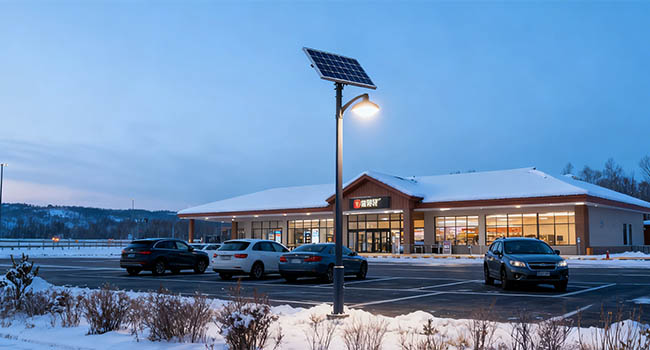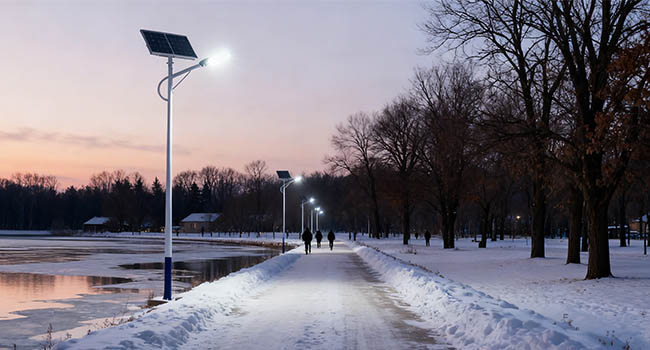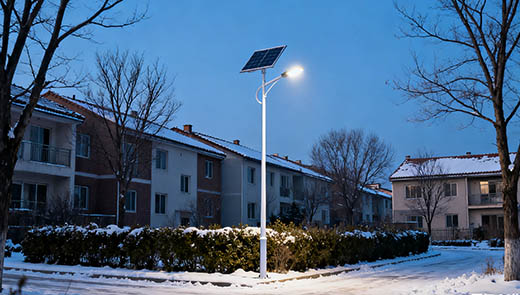Can Solar Street Lights Work Efficiently in Winter?
As demand for renewable energy solutions continues to grow, solar street lights have become a popular choice for urban and rural lighting projects worldwide. However, a common question among purchasers, installers, and local authorities remains: Can solar street lights operate efficiently during winter?The answer is yes. With proper design, standardized installation, and regular maintenance, solar street lights can operate reliably even in cold, low-light winter conditions. This article breaks down the core factors affecting winter efficiency, the key technologies enabling year-round operation, and practical tips for optimizing performance during colder months.

Core Challenges Faced by Solar Street Lights in Winter
Significantly Reduced Sunlight Duration
Winter features shorter days and longer nights, compressing the “working window” during which solar panels—the core component of solar street lights—absorb sunlight and convert it into electricity. This leads to reduced daily power generation, directly weakening the energy storage foundation for nighttime illumination. Additional technical measures are required to compensate for this power generation gap.
Significantly Reduced Light Intensity
Winter often brings cloudy skies, smog, and frequent snowfall in some regions. These factors diminish the solar irradiance reaching the ground, making it difficult for solar panel efficiency to reach optimal levels even during daylight hours. This further exacerbates the issue of insufficient power generation, with the impact becoming particularly pronounced during prolonged periods of cloudy or snowy weather.
Low Temperatures Impact Battery Performance
While moderate cold (e.g., 0°C–10°C) may slightly enhance the performance of certain batteries (like lithium batteries) used in solar street lights, temperatures below -20°C slow down the chemical reaction rates within the batteries. This can lead to reduced battery capacity and discharge efficiency. Solar street lights that could previously sustain illumination throughout the night may experience power outages midway in extremely cold conditions.
Snow Accumulation Blocking Power Generation
Snow buildup on solar panel surfaces completely blocks sunlight, preventing power generation until the snow melts or is cleared. Given slow winter snow melt, untimely removal may cause solar lights to fail to store energy for consecutive days, compromising nighttime lighting stability.
Key Technologies for Efficient Winter Operation of Solar Street Lights
High-Efficiency Solar Panels
Different types of panels exhibit significant performance variations in low-light winter conditions. Specific comparisons are as follows:
|
Solar Panel Type |
Efficiency Range |
Low-Light Response |
|
Monocrystalline Panel |
20%–25% |
Strong; can generate power under diffused light |
|
Bifacial Monocrystalline Panel |
18%–22% |
Strong; absorbs light from both sides |
|
Polycrystalline Panel (Traditional) |
15%–18% |
Weak; requires strong light for efficient power generation |
Currently, mainstream solar street lights predominantly utilize monocrystalline or bifacial silicon panels. Both generate 15%-25% more power than traditional polycrystalline panels under low-light winter conditions. Monocrystalline panels, with their superior low-light response, are more widely adopted in solar street lights deployed in regions with frequent cloudy and foggy winters. Bifacial silicon panels, with their dual-sided light absorption capability, are suitable for solar street lights installed in environments with abundant reflected light, further enhancing energy collection efficiency.
Low-Temperature Resistant Lithium Batteries
Traditional lead-acid batteries suffer significant performance degradation in cold temperatures. Modern solar street lights have fully transitioned to lithium iron phosphate (LiFePO4) batteries, which offer distinct advantages in winter. LiFePO4 batteries operate stably between -20°C and 60°C, accommodating solar street lights in most cold regions without requiring additional insulation. At -10°C, they retain over 80% of their rated capacity—far exceeding lead-acid batteries (which retain only 50%-60% capacity at -10°C)—ensuring sufficient energy storage for nighttime illumination even in frigid conditions.
Additionally, their service life under normal use reaches 8-10 years—more than double that of lead-acid batteries (3-5 years). This reduces maintenance frequency and replacement costs for solar street lights in winter cold environments while lowering repair difficulties during extreme cold weather.

Intelligent Energy Management System
Advanced solar street lights incorporate smart controllers that adapt to winter demands through three key functions, enabling efficient energy distribution and utilization.
MPPT Maximum Power Point Tracking Controller
Compared to traditional PWM (Pulse Width Modulation) controllers, MPPT controllers dynamically adjust voltage and current to track the maximum power point of solar panels, extracting maximum energy. Even under low winter sunlight and unstable solar irradiance, MPPT controllers boost energy collection efficiency by 20%-30%, enabling solar street light panels to store maximum energy within limited daylight hours.
Adaptive Dimming Function
Integrated with human presence sensors, solar street lights enable “on-demand dimming.” When no pedestrians or vehicles are detected, the lights automatically dim to 30%-50% brightness to reduce energy consumption. Upon detecting activity, the light instantly boosts to 100% brightness to ensure safe illumination. This mode significantly reduces unnecessary energy consumption during long winter nights, extends battery runtime, and prevents premature shutdowns due to insufficient energy storage. It is particularly suitable for solar street lights in rural roads, residential communities, and other low-traffic nighttime scenarios.
Battery Protection Mechanism
The smart controller continuously monitors the solar street light's battery status, preventing damage from overcharging or over-discharging. During winter charging, as low temperatures slow battery charging speed, the controller automatically reduces the charging current once the battery reaches 90% capacity. This prevents issues like swelling or lifespan degradation caused by overcharging in cold conditions. During discharge, when the battery level falls below 20%, the low-voltage protection feature activates, halting power output to prevent irreversible damage from deep discharge. This ensures long-term, stable battery performance throughout winter.
Snow and Ice Prevention Design
To mitigate winter snow accumulation, the solar street light incorporates three design elements that reduce snow interference, ensuring continuous power generation from the solar panels.
Tilted Installation Structure
Solar street light panels are installed at a 30°-60°tilt angle, adjusted based on regional snowfall levels:
In areas with light snowfall, a 30°-45°tilt angle is used. This balances power generation while allowing gravity to naturally shed minor snow accumulation. In regions with heavier snowfall, solar street lights employ a 45°–60° tilt angle. This further enhances snow shedding, reduces the duration snow remains on the solar panel surface, and lowers the frequency of manual cleaning required for the solar street lights.
Anti-icing Coating Technology
Some high-end solar street lights feature hydrophobic anti-icing coatings sprayed onto their panels. This coating reduces the adhesion of snowflakes and frost to the surface, allowing accumulated snow to slide off more easily. It also prevents ice layers from forming on the panels during low temperatures. Even in alternating rain and snow conditions, the panels remain clean, ensuring normal light incidence and minimizing power generation losses caused by ice obstruction.

Practical Optimization Techniques for Efficient Solar Street Light Operation in Winter
Optimize Panel Installation Orientation
In the Northern Hemisphere, orient solar panels directly south; in the Southern Hemisphere, point them directly north. Align with the winter sun's trajectory to maximize daylight exposure. Before installation, identify obstructions like trees or buildings. During winter, the low sun angle means even low obstacles significantly block sunlight.
Quarterly Adjustment of Panel Tilt Angle Increase the tilt angle by 10° above the standard setting during winter to enhance sunlight capture efficiency, enabling the panels to absorb more energy during shorter daylight hours. If obstructions cannot be avoided, elevate the installation height or fine-tune the panel angle to minimize power generation losses.
Regular Maintenance
When snow accumulation exceeds 2cm, gently brush off solar panels with a soft-bristled brush. Frozen snow can be melted using warm water below 40°C. Never strike solar panel surfaces with hard objects. Monthly inspections should verify connections between solar lamp batteries and controllers. Low temperatures may cause terminal loosening or corrosion. If corrosion is present, sand the terminals, reconnect them, and apply rust inhibitor to ensure uninterrupted electrical flow.
System Capacity Redundancy Design
Based on the shortest daylight hours during the winter solstice, increase the solar panel power by 30%-50% to ensure sufficient daily energy generation for nighttime illumination. Select battery configurations capable of sustaining 3-5 days of operation without sunlight to withstand consecutive cloudy or snowy days, preventing shutdowns due to power depletion. For example, a 10W solar street light requires a 12V/100Ah or larger lithium iron phosphate battery to guarantee basic illumination during extreme weather.
Real-world Case Study: Winter Efficiency in Solar Street Lights
Scandinavia (Norway, Sweden)
Average winter temperatures in this region range from -15°C to -30°C. High-latitude areas experience polar nights with only 2-3 hours of daily sunlight. Municipal authorities deployed solar street lights featuring monocrystalline silicon panels paired with lithium iron phosphate batteries. Combined with MPPT controllers to enhance low-light power generation efficiency, these systems achieved 100% operational uptime during winter.
Alberta, Canada
Annual winter snowfall in this region reaches up to 150cm, with prolonged snow cover making traditional grid-connected street lights prohibitively expensive to maintain. Solar street lights introduced in rural communities feature dual-crystalline silicon panels with anti-icing coatings. The panels are tilted at 50° to accelerate snow shedding, while adaptive dimming functionality reduces energy consumption. In practice, winter illumination performance matches summer levels, achieving 80% energy savings over traditional lights and significantly lowering local solar lighting expenses.
Heilongjiang Province, China
Heilongjiang Province experiences extreme winter temperatures as low as -40°C, coupled with heavy and prolonged snowfall, demanding exceptional cold resistance and snow accumulation prevention capabilities from solar street lights. The solar street lights deployed locally feature self-heating monocrystalline silicon panels paired with intelligent temperature control systems to maintain optimal battery operating temperatures. Research data from 2023 indicates these solar street lights achieved 98% operational reliability during winter, with only 2% of failures stemming from frozen wiring caused by extreme blizzards. This issue was subsequently resolved through enhanced wiring protection measures.
The core of efficient winter operation for solar street lights lies in targeted design: selecting core components suited for winter conditions, adopting snow- and ice-resistant installation structures, and implementing regular maintenance alongside capacity redundancy design. Solar street lights that undergo scientific selection and standardized management can adapt to the winter environments of cold regions, becoming a cost-effective green lighting choice.




